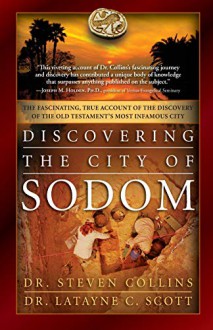
The Genesis 18-19 account of the destruction of Sodom and Gomorrah has become part of the Western cultural zeitgeist and its location a mystery ever since the beginning of Biblical archaeology. Discovering the City of Sodom: The Fascinating, True Account of the Old Testament’s Most Infamous City by Steven Collins and Latayne C. Scott goes into the decade-long excavation of a site in Jordan that Collins purposes the evidence points towards it being the location of the destroyed city.
Much of the book is written by Collins who first explores the everything around the account of Sodom in Genesis and denoting that it must be read “authentically” not “literally”. One of Collin’s most important points early on is looking at the actual Hebrew wording of the text and what important words actually mean, this factors into where Collins believes the Bible locates the city of Sodom not at what is the bottom of the southern Dead Sea or on its southeast coast but on the eastern side of the Jordan River opposite Jericho. After laying out what the Bible actually says about Sodom and the historical era the Bible describes it in—the Middle Bronze Age—Collins then goes into the what his numerous archaeological excavations at Tall el-Hammam have made him believes he’s found Biblical Sodom including the fact that after the large city that was located there was destroyed in the Middle Bronze Age, nothing was rebuilt there until the Iron Age around 700 years later. Scott’s contribution was related Collin’s professional journey giving tours that located Sodom at the traditional southern Dead Sea location to his letting reading of the Bible lead him to look for a large prosperous city in the Jordan plain across from Jericho and the discoveries made at el-Hammam that made Collins realize he had found the city of Sodom.
Both Collins and Scott did a very good job with their respective parts of the book with Collins focused on the academic side and Scott doing a biographical look at Collins’ personal journey over several decades when connected to this subject. The biggest positive of the book is Collins’ balance of keeping to the authenticity of the Biblical account and dealing with facts found in the dirt, not only at el-Hammam but across the Levant. The biggest issue with the book is the same as another book by Collins’ and that is layout as the maps were placed in the back of the book and not nearer to the relevant text where they would be helpful. However, given that there were two authors the change of font style denoting when each author was writing was a very choice.
Discovering the City of Sodom is an enlightening read with Collins’ engaging writing that made what could have been dry academic details lively while Scott’s biographical sketches give a more personal touch. While the layout of the book is a bit of a mixed bag with differing fonts denoting which author was writing is a positive, the placing of maps in the back of the book instead of near the text that they illustrated is a negative. Whether you agree with Collins’ archaeological discoveries and research, this is a informative read about the era of the Middle Bronze Age in the Levant.

 Log in with Facebook
Log in with Facebook 





